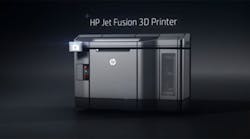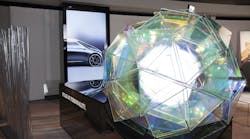Latest from Industry Trends
PALO ALTO, California — England and Portugal established their alliance back in 1373, 644 years ago, the oldest alliance anywhere around the globe still in force. If the alliance formally announced Thursday by HP Inc. and Deloitte lasts anywhere near that long, the industrial world will be the biggest beneficiary.
Of course, given the current rate of technological change, who knows what the industrial world will look like in 2661. Let’s stick to the present.
HP and Deloitte have formed what they call an alliance, this one hinged on additive manufacturing. HP CEO and president Dion Weisler and Deloitte global CEO Punit Renjen were on hand Thursday at HP’s historic Silicon Valley offices, their joint statements delivered just down the hall from the offices where Bill Hewlett and Dave Packard built their namesake company into a tech giant with their doors always opened.
Both companies are relatively new to additive manufacturing. HP, of course, entered the space late last year with the introduction of its Multi Jet Fusion printer. As a professional services firm, Deloitte works with companies that use the tech, but top execs have given it extra weight of late.
“There is a way to make a very broad impact on the way companies all around the world design, procure, manufacture and deliver their products to customers all over the world,” Weisler said. “Everything that’s going on with connected factories, with AI, with robotics, with 3D printing — all those things, when you combine them enable manufacturing to happen anywhere in the world. You can democratize manufacturing in a way that hasn’t taken place since the blacksmiths had to give up their tools. All we’re doing is giving those tools back.”
Here's a Q&A with Weisler and Renjen explaining how this partnership can help manufacturers:
Dion Weisler: Manufacturing can happen much closer to where end customers are. Parts transfer themselves digitally. And what we realized when we set out on this journey was that it was going to be difficult for any one company to lead this transformation. We had incredible technology, we drew on more than 30 years of information from business in microfluidics, and we built an ecosystem of strategic partners, materials partners … that are keen to transform themselves and provide a difference in a world where you don’t have to have the inventory, the cost of capital, warehouses tied up.
What we realized by having this ecosystem is that there are almost no skills out there, because this is so fresh and so new. We needed the world leader in digital transformation to come scale this business with us.
Punit Renjen: What is it that we’re trying to get here? Why now? And how? Dion said, ‘We’re here to change a $12 trillion industry that is ripe for disruption.’ From my vantage point, that disruption has three dimensions: speed, from design, to prototyping, all the way to manufacturing; flexibility, so you can custom manufacture; and then efficiency.
Why now? For one, the technology is mature. Digitization is both a natural disruptor, as well as a great opportunity — and it’s not just 3-D printing. We’re seeing it with robotics, we’re seeing it with artificial intelligence, and it’s the confluence of all that that makes this such a great situation. And then, importantly, despite what politicians are saying, globalization is giving customers all over the world the choice and the flexibility to demand things that are customized.
Industry Week: Why form a partnership, a relationship, or as it’s been coined, an alliance?
PR: We could have partnered with anybody. We picked HP because we believe they are the world leader in technology. This is the fourth industrial revolution. We were around for the first, and HP invented the third. It is exclusive, and the intent is to always start with the customer need and address it in the best way in their interest. In many cases, we will bring HP’s technology capability to solve that problem — but we might bring others, like SAP, other alliance partners, to address the problem in the best possible way. The intent is not to go to market and have a hammer trying to find nails.
DW: The whole point of the alliance is so we don’t step on each other’s toes. We have technology, but we need the world’s leader in transformation. We can’t do what they do, and they can’t do what we do.
IW: How much are you going to do now, and how much are you going to do in the future? You did $13 billion last quarter, and this is a good test case for other industries.
DW: Thirteen point one (laughs). Of course, the 3-D printer that we released back in December, one of the fun facts there was that 50% of the custom plastic parts inside that printer were printed by the printer, so the printer is kind of printing itself. I got together with the team and said, ‘Guys, you have to slow down. Your technology advancement here is a fundamental flaw in the business model. You can’t just sell one model and have it keep printing itself.’ It reminds you of Star Trek and the replicator that can make anything.
As a result of that, one of the biggest things we found, one of the biggest problems, is that our 3-D print team well understood the advantages of 3-D printing, but we are a traditional manufacturer. We’ve been doing that in a traditional way for a very long time, so we don’t have the skills in house in every division of our company to be able to make that transformation. So that’s when Punit and I got together and said, ‘What a great test case. Let’s use HP as a test case for looking at the bill of materials of some our products to see what we could make using digital manufacturing and what we still had to make using analog manufacturing.’ What we discovered through that process was that it took a whole bunch of really great minds coming at it from different angles and that if we were going to build that to scale, we would need to be able to build tools, processes, capabilities to be able to do that for customers.
We are on that journey internally, not just with our traditional manufacturing but with our spare parts. We see that as an amazing start. Imagine if we didn’t have to store spare parts all over the world for every device we’ve ever made. What if we could just print them as we needed them?
IW: It seems like the winner is not the tech, and not the company that stitches it all together, but rather the consumer and the end user. How do you envision this working? What will happen as Deloitte and HP engage companies who want to benefit from the platform and the capabilities?
PR: We have to start with the customer and make sure the impact we have on that customer materially improves their lives and the product we sell them is customized to what the technology offers. …The way we will lever this alliance is to look at the customer need as to how to change the supply chain or to fundamentally change their manufacturing processes, then rate an ecosystem. That will bring a bespoke answer.
IW: The vast majority of manufacturers are small and mid-sized enterprises. To what extent do you expect this to be available not only to the large organizations, but also those smaller and mid-sized that could benefit from this?
DW: That’s what’s truly gratifying about this, is that we’re able to democratize manufacturing and it’s available to everybody. … We want this technology to be available to everybody, everywhere, so we enable that through our go-to-market strategy and leverage the ecosystem to make sure that we’re fueling the capabilities of companies big and small.
PR: We’re a private company, and 30% of our global revenue comes from selling to 80% of the Fortune 500. So 70% comes from the small and mid-sized enterprises. Our intent is to democratize this, so maybe we start with the Fortune 500s to build the use cases, then democratize it.
Please visit Industry Week for the rest of the story,













